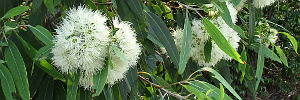
Related Topics: |
|
Information about plants & gardens for Brisbane & Qld |

|
|||
| |||
Note that the majority of these trees are unsuitable for home gardens. There are, however a few suitable for the suburbs, including the grafted eucalypts selected for outstanding flowers.
There is a massive amount of information about eucalypts online already. This page will concentrate on species suitable for average gardens in the tropics and subtropics. plus some interesting news items concerning the group.
Ongoing testing and cataloguing of significant trees in Logan City has identified more notable residents. A forest red gum (Eucalyptus tereticornis) at Jimboomba has been estimated at 359 years old. This is not far behind the 380 year-old "Gandalf", a North Maclean tallowwwod (Eucalyptus microcorys) that was scientifically dated 3 years ago. A 270 year-old thick-leaved mahogany (Eucalyptus carnea) was also found at Priestdale in the recent round of testing. Age is determined by inserting a very thin drill into the trees' trunks and using variation in resistance to detect and count the seasonal growth rings. Source: New giant of the forest (October 2022)
In many parts of the world, Australian eucalypts are useful species that have also become troublesome weeds. An international collaboration has recently introduced sterility into a timber variety of Eucalyptus using CRISPR gene editing technology, the first time it has been successfully used for commercial forestry. This removes the weed potential of the tree, although laws against GMO crops would prevent use of this new strain from being planted in some places. Source: Research suggests eucalyptus trees can be genetically modified not to invade native ecosystems (April, 2021)
A blue gum (Eucalyptus tereticornis) already recognised as one of Logan's oldest trees has been scientifically dated to about 378 years old. Differences in resistance (indicating the rings) were measured by probing the trunk. The tree has now been officially named "Gandalf". It's located on private property at North Maclean. With the cooperation of other landholders, Logan City Council is hoping to expand its tree age testing program to catalogue historic trees throughout the city. Source: Logan’s Gandalf is a grand old tree (July 2019)
A University of the Sunshine Coast team, led by Dr Stephen Trueman, have spent nine years researching which koala-friendly trees are most suitable for urban South-East Queensland, including backyards. They assessed around 20 species and variants, including grafting experiments. The only one that grew well and stayed sufficiently small was Eucalyptus kabiana ( Mt Beerwah mallee), reaching 6m in seven years. They can provide food and habitat for koalas and should be useful in creating corridors between existing habitats well away from dangerous roads. The first 350 seedlings to be planted across the Moreton Bay Region were given to the Moreton Bay Regional Council and the Pine Rivers Koala Care Association at the project launch. The next step is to assess them in various locations with different soil types. Source: Dwarf gum tree plantings to help safeguard koalas (July 2016)
A study of Eucalyptus melliodora at the Australian National University shows that mutations that occur during vegetative growth over a tree's long life can lead to some branches being more pest-resistant than others. In this case, the variation was explained by changes in terpene production. These genetic "sports" might be deleterious if carried by the whole plant, but do give a chance of survival under heavy insect attack. Source: Genetic variation controls predation: Benefits of being a mosaic (February 2013)
Although a distinctive feature of some Eucalypts, the cause of the "scribbles" on their trunks has until recently been little studied. The Australian Scribbly Gum Moth was thought to be the only species responsible, but thanks to a team of "retired" CSIRO scientists, we now know that at least twelve species of moths can create the phenomenon. Source: 'Retired' scientists unmask bush graffiti artist (November 2012)
Warning: collection, destruction, propagation, movement, sale or purchase of any Australian native plant (including seeds or spores) may be subject to laws and regulations. Be sure to check with appropriate authorities before engaging in these activities, even on private property. Other laws may also apply to the treatment and movement of plant or soil material (for example, to control the spread of weeds, pests and diseases.)
|
|
|
|
|
|
|
|
© Calyx Horticultural Services ABN 38 518 961 623
|